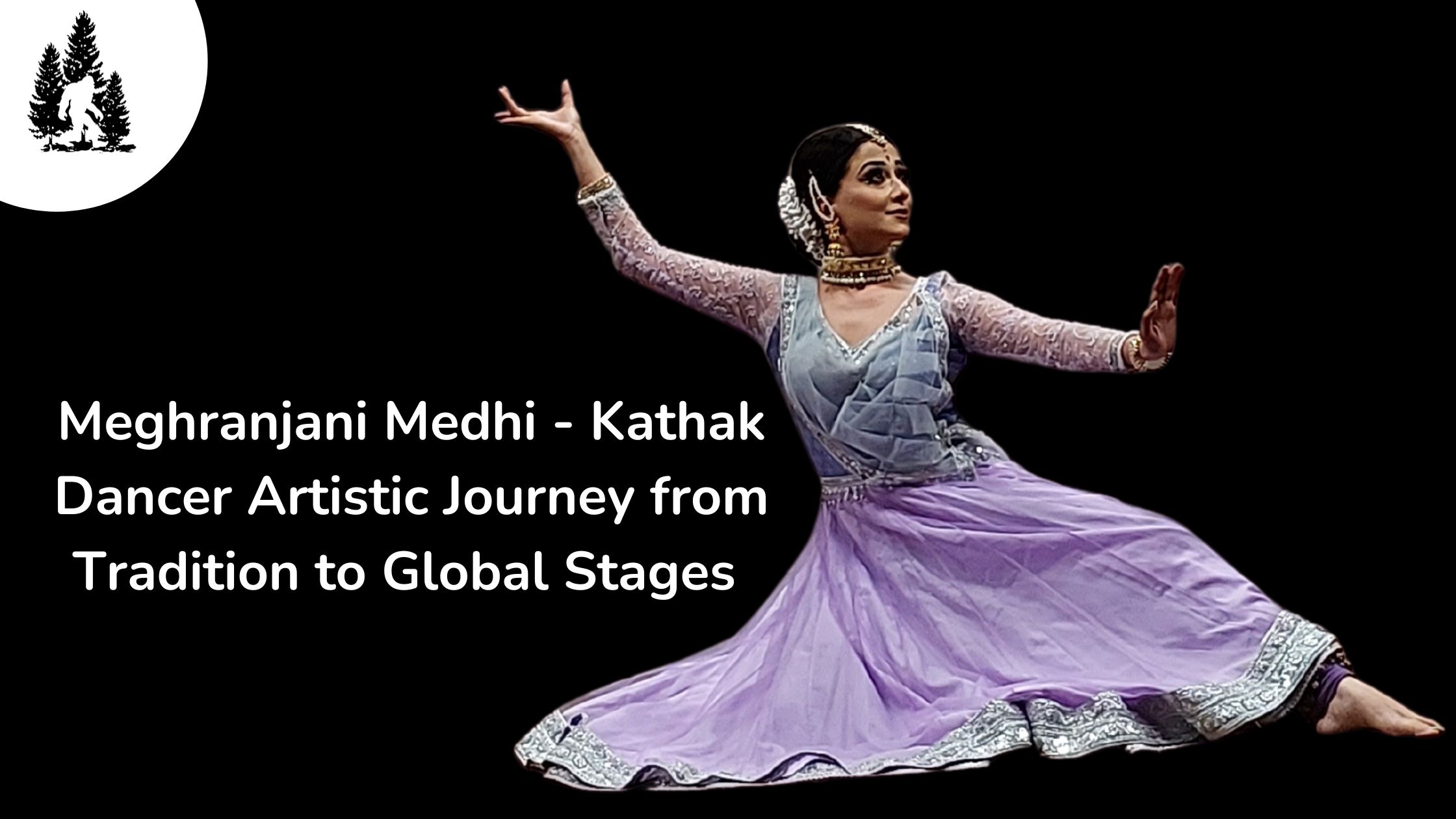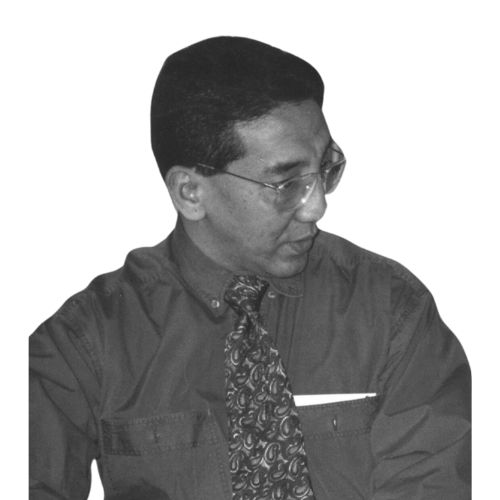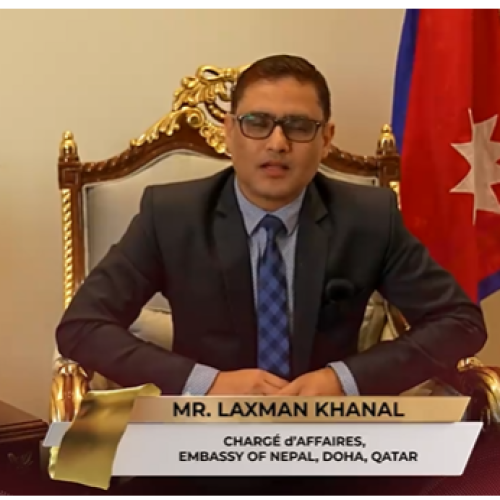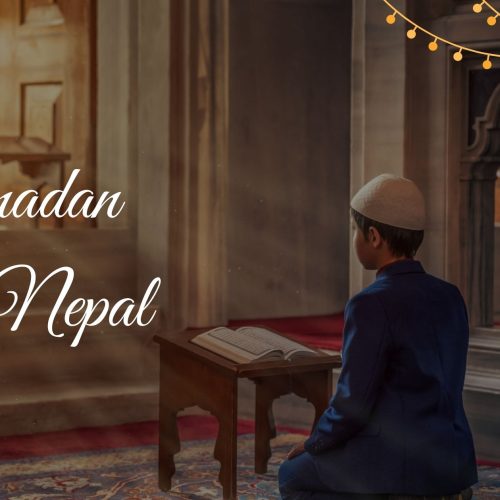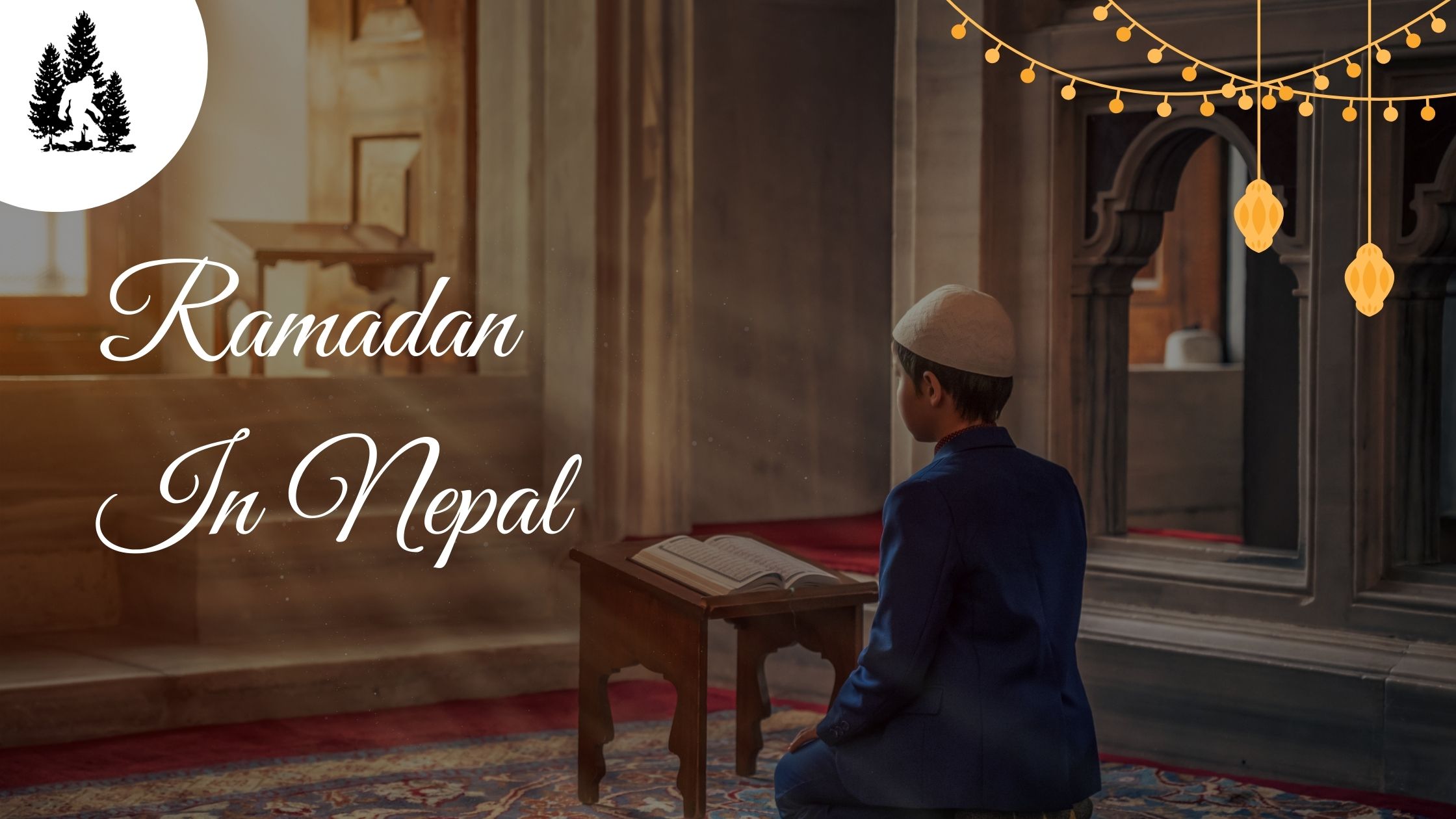Here You will know the Journey of Meghranjani Medhi – Kathak Dancer Artistic, but before you know What is Kathak.
Kathak is a dance form steeped in the tradition of storytelling, incorporating music, dance, and narration to create impactful performances. Historically, Kathak artists would traverse the land in small troupes, carrying their musical instruments, and perform in different communities moving from one to another. These movements were often facilitated by village elders and thus the dates and venues could be pre-arranged. Such gatherings were vital for communal bonding and provided a platform for trade and networking.
The documentation and preservation of this art form have been influenced by religious, political, and personal interests, revealing contrasts between Indian and Western scholarly accounts. The traditional patriarchy of Kathak, where male teachers were addressed as “Guru-ji” and female teachers as “di-di” (big sister), has also undergone significant transformation.
Political changes over the centuries have affected Kathak’s fortune, witnessing periods of decline and resurgence. Icons like Akbar the Great, who showed profound support for the art due to his marriage to a Rajput princess, contrasted with rulers who lacked understanding or the desire to preserve it. Through challenging times, dedicated artists maintained their craft, leading to the respect and support Kathak enjoys today.
Kathak – its impact!
In today’s world, where storytelling is a coveted skill in the arsenal of businesses and influencers alike, Kathak’s narrative power remains relevant. The digital era is voracious for engaging content, and Kathak offers valuable lessons for those seeking to captivate and retain audience attention. As technology and social media accelerate, the principles of Kathak storytelling have the potential to offer profound insights to content creators and digital marketers vying for the ever-elusive ‘eyeballs.’
In a stunning display of Kathak’s dramatic storytelling power, a performance I watched overseas encapsulated the ancient dance form’s visceral impact on audiences. The scene is etched in my memory: the formidable God Bhim, after delivering a punishing blow to his adversary Dussasana, lifts his head in a slow, deliberate motion. The background music crescendos, perfectly timed with Bhim’s piercing gaze – and his mouth dripping with blood – that transcends the stage and fixes the audience in a collective, mesmerizing hold.
The elaborate facial expressions, the dance movements meticulously synchronized with the haunting melody, and the vibrant colors adorning Bhim’s visage create an unforgettable tableau. The intricate shades of green, yellow, and red painted on his face are not just colors; they become a window into the soul of the character.
Then comes Draupadi – a strong, resolute wife of the five Pandava brothers. She has been earlier violated of her dignity by Dussassana. The moment Bhim smears Dussasana’s blood onto Draupadi’s hair stands as a poignant representation of justice served. Her slow, contented smile and the deliberate act of braiding her blood-soaked hair resonate with the theme of revenge fulfilled. It’s a scene that captures the ethos of an era where vows were as steadfast as destiny, and the gods themselves were agents of karmic retribution.
This portrayal of Draupadi, who had been mercilessly dragged by her hair on Dussasana’s orders, had vowed not to bind her tresses until she could anoint them with the blood of her tormentor. The Kathak performance brings this pledge to life with a vividness that is almost tangible.
Such is the power of Kathak: to tell a story so compelling that it leaves an indelible impression. It weaves narratives of strength, of profound characters embroiled in fateful twists, into the very fabric of the spectator’s consciousness. This was not just dance; It was a living, breathing enactment of vengeance, valor, and victory that stays with me long after the final bow.
Who is the Assamese actress Meghranjani Medhi?
Born into a family of distinguished artists, Meghranjani Medhi began her artistic journey at the tender age of three under the tutelage of her mother, Marama Medhi, an expert in Kathak dance. Her father, Joy Prakash Medhi, is a celebrated vocalist, composer, and music director hailing from Assam.
Throughout her life, Meghranjani has navigated the demands of her academic pursuits alongside her career in dance and acting. This impressive balance has not gone unnoticed; she is the proud recipient of numerous awards and scholarships and has showcased her artistry globally.
Meghranjani exudes a captivating presence as a Kathak dancer—her demeanor is charismatic, her speech gentle, and her movements imbued with grace. Her ingenuity lies in how seamlessly she integrates her familial heritage into her performances, adding a personal touch that endears her to audiences. Currently, she is in New Zealand with her husband, Neil Das, who is also a talented artist known for his sophistication and flair.
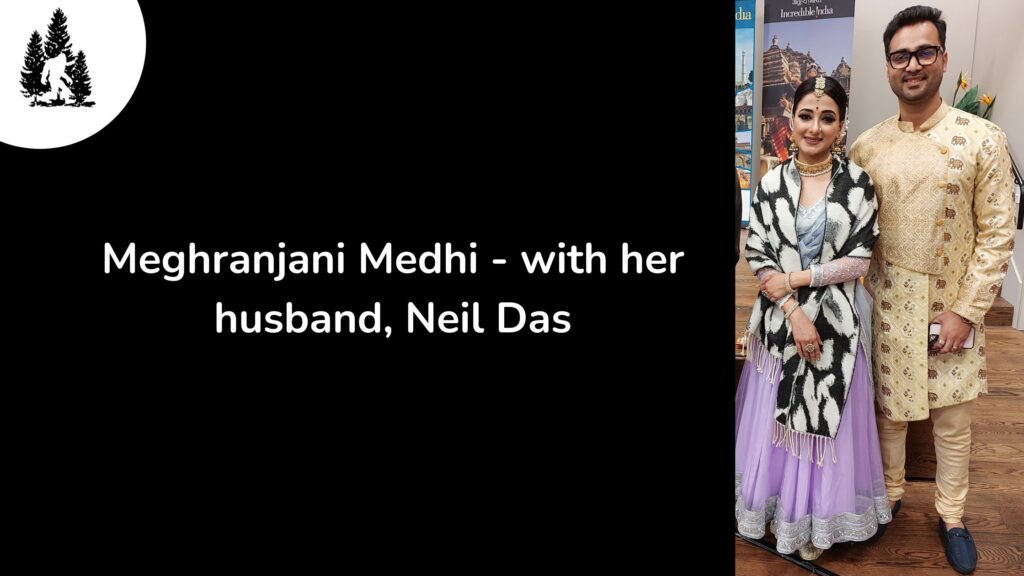
With over twenty-five years of diligent practice, Meghranjani has evolved into a performer who radiates confidence and sophistication. She approaches the Western cultural landscape with an assured stride, fully aware of her artistic strengths, yet without any urgency to overtly seek approval.
Meghranjani Medhi Renditions in Wellington
Meghranjani Medhi’s performance starts with Shiva Vandhana
Her first performance in Wellington was the Shiva Vandhana. She starts with a respectful greeting to the god Shiva, using gentle hand motions and facial expressions to show admiration. As the dance goes on, the dancer uses the quick spins and precise steps that Kathak is known for. These moves are meant to represent the never-ending cycles of the world, like creation and destruction, which are part of Shiva’s power.
The beats and rhythms that the dancer recites or that are played in the music help tell stories from Shiva’s life, like his joyful dance or his quiet meditation that keeps the universe in balance. This way, the Kathak dance dedicated to Shiva is more than just a performance. It’s like a moving prayer that makes the sacred feel present in the here and now, using the dancer’s own body to do so.
Yashoda and Krishna
She also does the popular Kathak dance that tells the story of Krishna, the playful child god, getting into mischief. The dancer starts with a twinkle in her eye, her feet tapping lightly to mimic Krishna sneaking around. She uses her hands to show him reaching for the freshly churned butter, his favorite treat, which his mother Yashoda has just made.
The dancer’s movements are quick and cheeky as she shows how Krishna grabs the butter. Her face is full of the naughty joy that Krishna feels. But then, she changes her expression to show Yashoda’s surprise and pretend anger as she catches her son in the act.
As the dancer moves around the stage, her steps get more excited, just like Krishna trying to escape with his prize. But then, she shows Yashoda’s mock sternness with a wagging finger and a shaking head. Even as she tries to look upset, the dancer’s eyes laugh, showing Yashoda’s deep love for her mischievous child.
With twirling spins and playful gestures, the dancer makes us feel the chase around the room. But it’s all in fun, and soon the dance slows to show Yashoda’s feigned anger melting away. She can’t stay mad at her little naughty son Krishna. The dancer’s arms open wide, inviting Krishna into a warm, loving embrace, even as her feet keep the lively rhythm of the dance.
This Kathak dance tells a charming story of a child’s playful antics and a mother’s love, all through expressive gestures, joyful movements, and the bond between Krishna and Yashoda.
Meghranjani Medhi’s Onstage Presence
The dancer’s charisma is undeniable, drawing every eye to the stage the moment she steps into the spotlight. She possesses a remarkable ability to engage with those watching, inviting them into a beat that demands focus—though paying attention is hardly a chore, given the enchanting quality of her movements and the rhythmic beats that guide them.
Her performance is a symphony of counts and taps, beginning with a captivating pattern of five that beckons the audience to join in the silent count (tap, tap). She then seamlessly transitions into a sequence of seven, and later, a complex rhythm of nine. The room is filled with an air of collective concentration, the spectators synchronizing with the dancer’s tempo, finding themselves part of a spontaneous chorus of rhythmic unity.
The experience is delightful, and there’s a palpable sense of satisfaction among the audience members as they catch on to the patterns. It’s more than just watching a dance—it’s an interactive journey, one that leaves the audience feeling exhilarated and connected, not only to the performance but to each other. They are participants in this dance, and their perfect alignment with the rhythm is a shared triumph, a communal joy that transcends the typical boundaries of performer and spectator.
Meghranjani Medhi – an interview
As the evening sky painted itself in the soft shades of dusk, a special event was taking shape—an educational and cultural experience centered around the art of Kathak. It was an evening dedicated to the appreciation of artistry and craftsmanship, where a sense of unity flowed through the gathering like a melody. Every movement and every rhythm was a celebration of collective harmony.
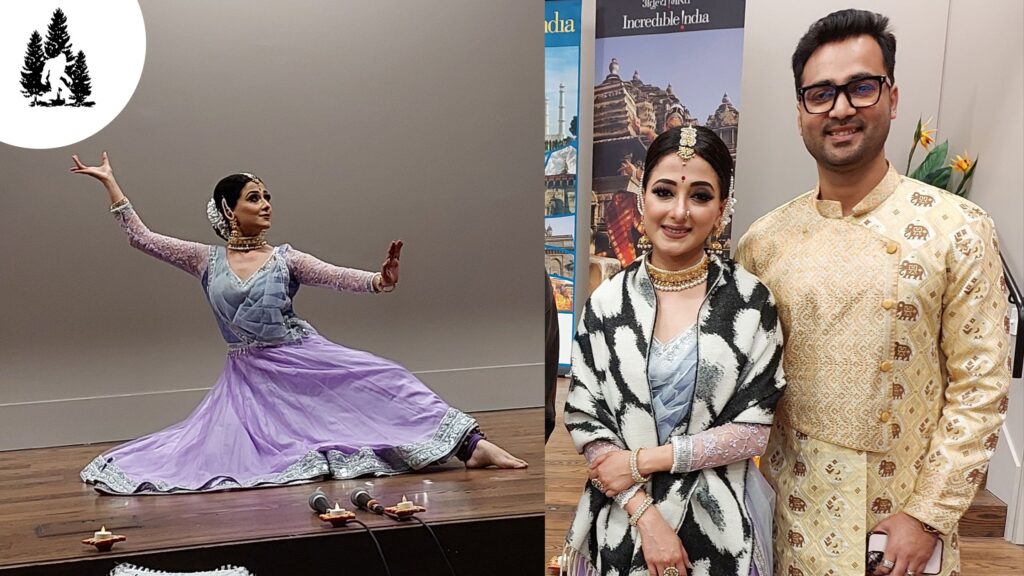
After the performance, the atmosphere during my interview with her was serene and welcoming, akin to the comforting ambiance of a family home. As she spoke, her words drew us into her world, inviting a closer connection. Her partner, present by her side, was acknowledged not just as a spouse but as an integral part of her artistic journey. She spoke of his unwavering support with quiet gratitude—it was clear that his role in her life was as significant as the steadfast base of a sculpture, providing the foundation upon which her creativity could flourish.
Their lives were beautifully entwined, his influence subtly present in her achievements. She spoke of him with a soft reverence, proud of the space he occupied in her life and work. Standing together, they were a team—the artist and the inspiration, the performer, and the support system. In the rhythmic narrative of Kathak that they both lived and told, it was evident that love was their chosen beat, a shared cadence that guided their journey.

